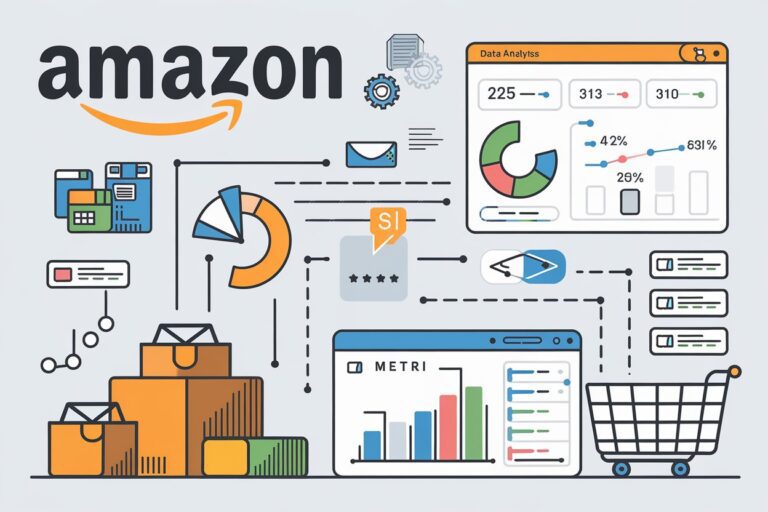Introduction
Amazon holds a pivotal position in the global e-commerce landscape. For thousands of sellers, whether they can stand out in this highly competitive market, data analysis becomes a crucial skill. As the Amazon platform continues to evolve, how to use data to optimize operations, increase sales, and maximize profits has become the core challenge for every Amazon seller.
Data-driven decision-making is an indispensable part of modern e-commerce operations. By deeply analyzing the data provided by the platform, sellers can gain precise market insights, optimize operational strategies, and enhance customer experience, leading to overall performance improvement. Thus, building a comprehensive data analysis process, from data collection to insights extraction, is critical for Amazon operations.
The Impact of Data-Driven Decisions on Performance Improvement
Data-driven decisions allow businesses to precisely understand market trends, optimize supply chain management, improve advertising efficiency, and accurately target customers, ultimately increasing sales. For example, if advertising is done without data support, it may lead to budget waste. However, by analyzing advertising platform data, strategies can be adjusted in real-time to maximize the return on ad spend (ROAS). Similarly, data analysis in inventory management helps avoid overstocking or stockouts, ensuring smooth operations.
Core Steps of Data Analysis in Amazon Operations
Amazon data analysis is a systematic process that includes several steps such as data collection, data cleaning, data classification, and analysis. Below, we will break down each of these steps.
2.1 Data Collection
Data collection is the starting point of Amazon data analysis. The accuracy and comprehensiveness of the data depend on the sources of data. In Amazon operations, the main data sources are as follows:
Amazon Seller Central Data
Amazon Seller Central provides a wealth of valuable operational data, including sales volume, order count, and return rates. Through Seller Central, sellers can clearly see the performance of each product, understand customer feedback, and assess advertising effectiveness. Regularly collecting this data is the foundation for analysis.
Amazon Advertising Platform Data
For sellers relying on advertising to increase exposure and sales, Amazon’s advertising platform offers detailed performance data such as click-through rate (CTR), conversion rate, and return on ad spend (ROAS). These data points not only help sellers optimize their advertising strategies but also provide strong support for new product launches.
Third-Party Tool Data
In addition to official Amazon data, third-party tools are equally important. These tools often provide more detailed market analysis, competitor tracking, and keyword research features. For example, competitive analysis tools help sellers understand competitors’ pricing strategies and product movements, while keyword research tools reveal which keywords drive more traffic and conversions.
Introduction to Pangolin Data Services
To enable sellers to efficiently collect, analyze, and use the massive data on the Amazon platform, Pangolin offers three core products: Scrape API, Data API, and Pangolin Collector.
- Scrape API: A comprehensive data scraping solution for the entire Amazon platform. It can quickly crawl Amazon’s site data, covering critical fields such as product details, prices, reviews, and inventory. This is suitable for sellers and developers who need large-scale data extraction.
- Data API: This API provides real-time parsed Amazon data, efficiently extracting and organizing data to help sellers stay updated with market changes and product performance.
- Pangolin Scraper: A visual tool allowing users to easily select fields for collection and export data in Excel format, suitable for non-technical personnel.
2.2 Data Cleaning
After data collection, the next step is data cleaning to ensure the integrity and accuracy of the data. Common tasks in data cleaning include:
- Data format unification: Data from different sources may have inconsistent formats, so unifying them is essential for subsequent analysis.
- Outlier handling: Extreme values or erroneous data may appear in the dataset, and cleaning these outliers prevents analysis bias.
- Missing value handling: Some fields may have missing values, and handling these missing values reasonably improves data reliability.
2.3 Data Classification
After data cleaning, the next step is to classify the data for subsequent analysis. In Amazon operations, data is generally classified into the following categories:
- Sales Data: Includes order volume, sales revenue, return rates, etc.
- Inventory Data: Involves inventory levels, inventory turnover rates, and is used to optimize inventory management.
- Customer Data: Includes customer purchasing behavior, shopping cart data, feedback, and reviews.
- Competitor Data: By analyzing competitors’ pricing, reviews, and sales, sellers can identify opportunities in the market.
2.4 Data Analysis
After classifying the data, we move on to data analysis. Common methods include:
- Descriptive analysis: Summarizes historical data to describe the current state of operations. For example, by analyzing sales data, sellers can understand which products are performing well.
- Diagnostic analysis: Investigates causes behind operational issues. For example, diagnosing why sales are declining could reveal advertising shortages or poor pricing strategies.
- Predictive analysis: Uses historical data to forecast future market trends and sales performance.
- Prescriptive analysis: Based on analysis results, provides optimization suggestions. For example, based on inventory data analysis, sellers can adjust their stock plans.
Key Performance Indicators (KPIs) in Amazon Data Analysis
When conducting data analysis, sellers need to focus on several key performance indicators (KPIs) that directly influence the success of operations. Below are some important KPIs:
Conversion Rate
Conversion rate refers to the percentage of visitors who ultimately make a purchase after viewing a product. By analyzing conversion rates, sellers can evaluate the attractiveness of their product pages and the effectiveness of their pricing strategies.
Average Order Value (AOV)
AOV reflects the average amount spent on each order. Increasing AOV allows sellers to boost sales without needing to increase customer numbers.
Repeat Purchase Rate
Repeat purchase rate is a key indicator of customer loyalty. By analyzing this rate, sellers can understand customer buying habits and launch targeted promotions to encourage repeat purchases.
Inventory Turnover Rate
Inventory turnover rate is an important indicator of inventory management efficiency. By analyzing this rate, sellers can optimize inventory management, avoiding cash flow problems caused by overstocking or lost sales due to stockouts.
Return on Ad Spend (ROAS)
ROAS is a critical indicator of advertising performance. By optimizing ROAS, sellers can increase the efficiency of their ad spend, making the most of their advertising budget.
Data Collection Channels and Their Characteristics
4.1 Official Channels
Amazon provides several official data collection channels where sellers can obtain detailed data:
- Amazon Seller Central: Offers basic operational data such as sales, orders, and returns.
- Amazon Brand Analytics: Provides more customer insights for brand owners.
- Amazon Advertising Console: Detailed advertising data, including CTR, ROAS, etc.
4.2 Third-Party Tools
Third-party tools help sellers collect more comprehensive market and competitor data. For example:
- Competitor Analysis Tools: Track competitors’ product performance and analyze their pricing and market strategies.
- Keyword Research Tools: Help sellers discover high-performing traffic keywords and improve search rankings.
4.3 Advantages of Pangolin Data Services
Pangolin’s data services offer efficient solutions to data collection challenges:
- Scrape API: Comprehensive Amazon site coverage with real-time updates.
- Data API: Efficient parsing of Amazon data, ready for immediate use.
- Pangolin Collector: A user-friendly interface for visual collection and convenient export, perfect for non-technical users.
Strategies for Ensuring Data Timeliness and Accuracy
To ensure the effectiveness of data analysis, sellers need to adopt strategies to guarantee data timeliness and accuracy.
- Real-time data update mechanism: Ensures that decisions are based on the latest data every time.
- Cross-verification of data from multiple sources: Verifies the accuracy of data by cross-checking it against multiple sources.
- Data quality monitoring system: Establishes a system for monitoring data quality to promptly detect and correct errors.
Pangolin’s data services also incorporate rigorous quality control processes to ensure accurate and reliable data for users.
Case Studies in Data Analysis
6.1 Product Performance Analysis
By analyzing sales data, sellers can evaluate the performance of each product, identify the most potential products, and adjust promotional strategies accordingly.
6.2 Competitor Analysis
Through competitor data analysis, sellers can identify opportunities in the market. For example, by analyzing competitors’ pricing strategies, sellers can formulate more competitive prices.
6.3 Market Trend Analysis
By analyzing market trend data, sellers can predict market changes and prepare in advance.
6.4 Customer Behavior Analysis
Through analyzing customer shopping habits and feedback, sellers can improve their products, increase customer satisfaction, and enhance repeat purchase rates.
Data Analysis Tools and Skills
In the data analysis process, sellers need to master certain tools and skills:
- Excel for data analysis: A simple and quick tool for data analysis, suitable for beginners.
- Visualization tools (Tableau, Power BI): Use visual charts to more intuitively present data results.
- Programming languages (Python, R): Perform deep analysis of complex data, suitable for advanced analysts.
- Machine learning algorithms: Use models to predict future market and customer behavior.
Data-Driven Decision-Making
Based on data analysis, sellers can make more accurate decisions:
- Pricing strategy optimization: By analyzing market and customer data, adjust product pricing strategies to maximize profits.
- Inventory management improvement: By analyzing inventory data, sellers can optimize stocking plans to avoid stock shortages or excess inventory.
- Marketing campaign adjustments: By analyzing advertising performance and customer feedback, adjust marketing strategies in real-time to improve campaign results.
- Product development direction: By deeply analyzing customer needs, sellers can identify new product opportunities.
Data Security and Privacy Protection
In the process of data analysis, sellers must ensure data security and privacy protection to avoid data breaches and illegal use.
- Encrypted data storage: Ensures all sensitive data is stored with encryption to prevent unauthorized access.
- Access control management: Assign different access rights to users to prevent data misuse.
- Compliance considerations: Adhere to data privacy laws like GDPR to ensure data processing is legal and compliant.
Conclusion
In Amazon’s fiercely competitive environment, data analysis has become an essential tool for every successful seller. From data collection to cleaning, classification, and analysis, every step plays a crucial role in the final operational decisions. Through systematic data analysis, sellers can gain market insights, optimize operations, and improve performance.
The Importance of Continuous Learning and Optimization
Data analysis is not a one-time effort. As the market environment evolves, sellers need to continually learn new analysis methods and optimize their data analysis processes to stay ahead in the competition.
Actionable Recommendations
For Amazon sellers, building a comprehensive data analysis system is essential. Here are some key steps:
- Steps to build a data analysis system: From data collection, cleaning, and classification to analysis, gradually establish a complete data analysis process.
- Choose the right data service provider (e.g., Pangolin Data Services): Improve data collection and analysis efficiency through reliable data services.
- Develop the team’s data analysis capabilities: Invest in training your team to ensure efficient operation in every aspect.
With systematic data analysis, sellers can not only optimize their current operational strategies but also uncover more market opportunities and achieve long-term business growth.


